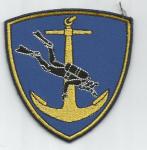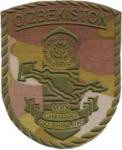ALICE Webbing (Combat Load) ( All-Purpose Lightweight Individual Carrying Equipment )
Випадкові:

Combat Divers Unit

Нарукавный знак Пограничных войск Службы национальной безопасности Республики Узбекистан

Badge of the Armed Forces of the Republic of Uzbekistan
Змінити інформацію
Інші версії
Please note: this item only covers the Combat Load portion of the ALICE system
Overview:
Equipment type: load-bearing harness with standardized pouches
Accessories: ALICE Existence Load and ALICE system backpack
Approx Carry Capacity: variable
Weight: variable
Designed: 1965 through 1973
Used: 1973 to present day
The ALICE System:
The All-Purpose Lightweight Individual Carrying Equipment or ALICE system is a system of straps, pouches, bags, and fasteners designed to allow a soldier to carry necessary equipment on their person without encumbering them or putting them under undue strain. The ALICE system is built around the ALICE system's individual equipment belt (NSN code: 8465-00-001-6487-series). The belt forms the base of the ALICE system and all parts of the ALICE system attach or interact with it.
Fighting Load:
Components of the fighting load are designed to provide the user with the necessary space to properly and securely store combat equipment.
Fighting Load Components:
-Belt, Individual Equipment (standard ver.): A wide, stiff olive drab Nylon belt with slate grey plastic ¨clip¨ type buckle the belt has two rows of brass eyelets. The eyelets are positioned above each other vertically approx. 1 inch apart and 2 inches between each row.( Example:|: : : : : : | ) All other ALICE components are attached to this belt.
-Carrier, Entrenching Tool: An EVA plastic ¨sheath¨ to secure a standard U.S.entrenching tool. The tool is secured with a top ¨flap¨ molded into the case. The case is closed by use of a metal button stamped in the ¨flap¨.
-Case, Field First Aid: A nylon olive drab pouch 8 1⁄2inches(22 cm) long when opened flat, and 4 1⁄2 inches(11 cm) wide it forms a 4 inch(10cm) deep pocket used to hold either a field dressing or standard first aid kit.
-Case, Small Arms Ammunition: A nylon olive drab magazine pouch or case, it holds 3 standard 5.56x45mm M16A1 magazines. The case holds and secures the magazines in place with 3/4 inch (1.9cm) webbing spacers present in the top of the case. The lid or top of the case fastens close with a plastic latch. On either side of the case are pouches, one per side these pouches are used to secure M-67 or any other standard size grenade to the user's person.
-Cover, water canteen: A nylon olive drab pouch or cover used to hold a standard US canteen, it is fasten closed my use of metal ¨snap¨ fasteners(buttons). On one side of the pouch, there is a smaller pouch used to hold water purification tablets.
-Suspenders, Individual Equipment Belt: Y pattern suspenders, they attach to the belt at a single point in the rear and slip into two length adjustable straps around the lower back and travel over the shoulders and attach at separate points on the font of the belt. The shoulder section of the suspenders are padded and the suspenders themselves are manufactured of Nylon Duck webbing and come in olive drab.
History:
The ALICE system was the end result of the LINCLOE program (Lightweight Individual Clothing And Equipment). The LINCLOE program was started in March of 1965 at the request of the WECOM (US Army Weapons Command) for a 30-round magazine pouch or carrier for use with the U.S. M16A1. The LINCLOE program explored and developed lightweight uniforms and equipment for U.S. troops in upcoming conflicts and its findings led to the adoption of the ALICE system in January of 1973. The adoption of the ALICE system resulted in the immediate termination of the LINCLOE program.
Overview:
Equipment type: load-bearing harness with standardized pouches
Accessories: ALICE Existence Load and ALICE system backpack
Approx Carry Capacity: variable
Weight: variable
Designed: 1965 through 1973
Used: 1973 to present day
The ALICE System:
The All-Purpose Lightweight Individual Carrying Equipment or ALICE system is a system of straps, pouches, bags, and fasteners designed to allow a soldier to carry necessary equipment on their person without encumbering them or putting them under undue strain. The ALICE system is built around the ALICE system's individual equipment belt (NSN code: 8465-00-001-6487-series). The belt forms the base of the ALICE system and all parts of the ALICE system attach or interact with it.
Fighting Load:
Components of the fighting load are designed to provide the user with the necessary space to properly and securely store combat equipment.
Fighting Load Components:
-Belt, Individual Equipment (standard ver.): A wide, stiff olive drab Nylon belt with slate grey plastic ¨clip¨ type buckle the belt has two rows of brass eyelets. The eyelets are positioned above each other vertically approx. 1 inch apart and 2 inches between each row.( Example:|: : : : : : | ) All other ALICE components are attached to this belt.
-Carrier, Entrenching Tool: An EVA plastic ¨sheath¨ to secure a standard U.S.entrenching tool. The tool is secured with a top ¨flap¨ molded into the case. The case is closed by use of a metal button stamped in the ¨flap¨.
-Case, Field First Aid: A nylon olive drab pouch 8 1⁄2inches(22 cm) long when opened flat, and 4 1⁄2 inches(11 cm) wide it forms a 4 inch(10cm) deep pocket used to hold either a field dressing or standard first aid kit.
-Case, Small Arms Ammunition: A nylon olive drab magazine pouch or case, it holds 3 standard 5.56x45mm M16A1 magazines. The case holds and secures the magazines in place with 3/4 inch (1.9cm) webbing spacers present in the top of the case. The lid or top of the case fastens close with a plastic latch. On either side of the case are pouches, one per side these pouches are used to secure M-67 or any other standard size grenade to the user's person.
-Cover, water canteen: A nylon olive drab pouch or cover used to hold a standard US canteen, it is fasten closed my use of metal ¨snap¨ fasteners(buttons). On one side of the pouch, there is a smaller pouch used to hold water purification tablets.
-Suspenders, Individual Equipment Belt: Y pattern suspenders, they attach to the belt at a single point in the rear and slip into two length adjustable straps around the lower back and travel over the shoulders and attach at separate points on the font of the belt. The shoulder section of the suspenders are padded and the suspenders themselves are manufactured of Nylon Duck webbing and come in olive drab.
History:
The ALICE system was the end result of the LINCLOE program (Lightweight Individual Clothing And Equipment). The LINCLOE program was started in March of 1965 at the request of the WECOM (US Army Weapons Command) for a 30-round magazine pouch or carrier for use with the U.S. M16A1. The LINCLOE program explored and developed lightweight uniforms and equipment for U.S. troops in upcoming conflicts and its findings led to the adoption of the ALICE system in January of 1973. The adoption of the ALICE system resulted in the immediate termination of the LINCLOE program.




